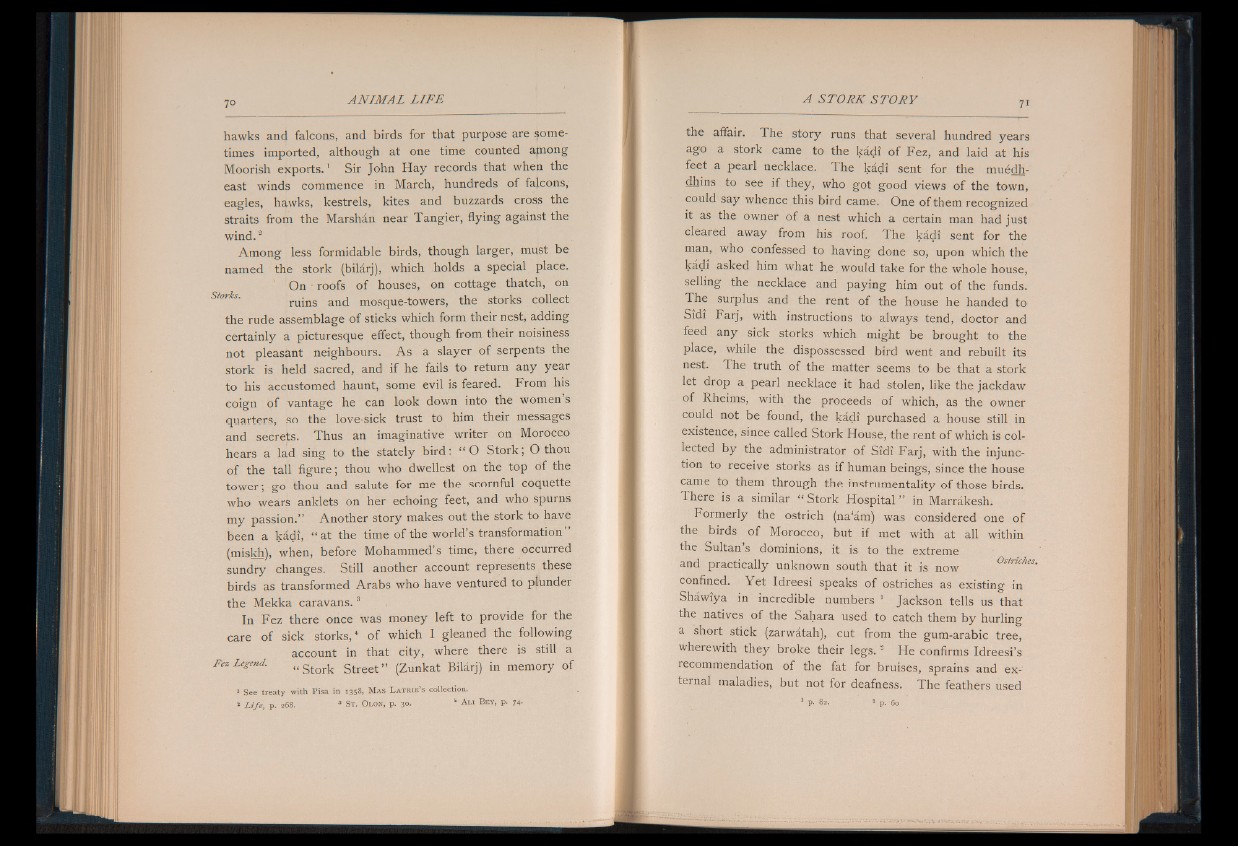
hawks and falcons, and birds for that purpose are sometimes
imported, although at one time counted apiong
Moorish exports.1 Sir John Hay records that when the
east winds commence in March, hundreds of falcons,
eagles, hawks, kestrels, kites and buzzards cross the
straits from the Marshan near Tangier, flying against the
wind.3
Among less formidable birds, though larger, must be
named the stork (bilarj), which holds a special place.
On • roofs of houses, on cottage thatch, on
ruins and mosque-towers, the storks collect
the rude assemblage of sticks which form their nest, adding
certainly a picturesque effect, though from their noisiness
not pleasant neighbours. A s a slayer of serpents the
stork is held sacred, and if he fails to return any year
to his accustomed haunt, some evil is feared. From his
coign of vantage he can look down into the women s
quarters, so the love sick trust to him their messages
and secrets. Thus an imaginative writer on Morocco
hears a lad sing to the stately bird: “ O Stork; O thou
of the tall figure; thou who dwellest on the top df the
tower; go thou and salute for me the scornful coquette
who wears anklets on her echoing feet, and who spurns
my passion.” Another story makes out the stork to have
been a kadi, “ at the time of the world’s transformation”
(miskh). when, before Mohammed’s time, there occurred
sundry changes. Still another account represents these
birds as transformed Arabs who have ventured to plunder
the Mekka caravans.3
In Fez there once was money left to provide for the
care of sick storks,4 o f which I gleaned the following
account in that city, where there is still a
Fez Legend. Stork Street” (Zunkat Bilarj) in memory of
1 See treaty with Pisa in 1358, M a s L a t r i e ’ s collection.
1 L if e , p. 268. 3 S t . Olon, p. 30. 4 A l i Be y> P- 74-
the affair. The story runs that several hundred years
ago a stork came to the kadi o f Fez, and laid at his
feet a pearl necklace. The kadi sent for the muedh-
dhins to see if they, who got good views of the town,
could say whence this bird came. One of them recognized
it as the owner of a nest which a certain man had just
cleared away from his roof. The kadi sent for the
man, who confessed to having done so, upon which the
kadi asked him what he would take for the whole house,
selling the necklace and paying him out of the funds.
The surplus and the rent of the house he handed to
Sidi Farj, with instructions to always tend, doctor and
feed any sick storks which might be brought to the
place, while the dispossessed bird went and rebuilt its
nest. The truth of the matter seems to be that a stork
let drop a pearl necklace it had stolen, like the jackdaw
of Rheims, with the proceeds of which, as the owner
could not be found, the kadi purchased a house still in
existence, since called Stork House, the rent o f which is collected
by the administrator of Sidi Farj, with the injunction
to receive storks as if human beings, since the house
came to them through the instrumentality of those birds.
There is a similar “ Stork Hospital” in Marrakesh.
Formerly the ostrich (na’am) was considered one of
the birds o f Morocco, but if met with at all within
the Sultan’s dominions, it is to the extreme
and practically unknown south that it is now Ostriches.
confined. Y e t Idreesi speaks of ostriches as existing in
Shawiya in incredible numbers 1 Jackson tells us that
the natives o f the Sahara used to catch them by hurling
a short stick (zarwatah), cut from the gum-arabic tree,
wherewith they broke their le g s .3 He confirms Idreesi’s
recommendation of the fat for bruises, sprains and external
maladies, but not for deafness. The feathers used